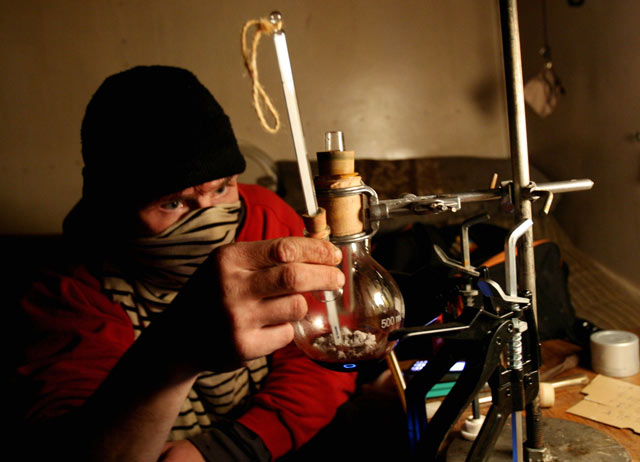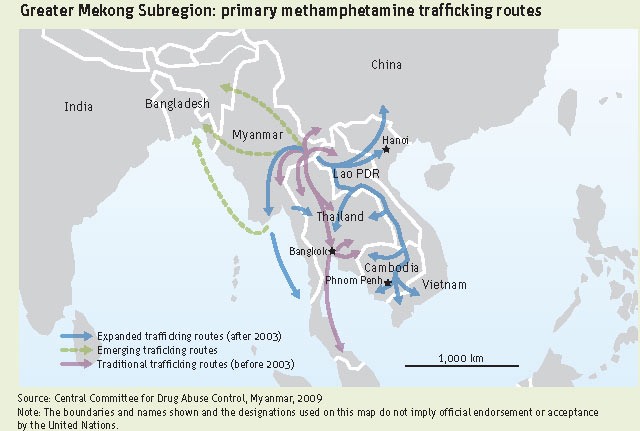The world’s drug cartels are preying on Southeast Asia
By Frédéric Janssens
Smuggling three kilograms of crystalline methamphetamine into Vietnam, a country known for its severe penalties for drug offences, was always going to be high risk. Yet for Preeyanooch Phuttharaksa this was a gamble that went dramatically wrong.

Meth lab: unlike its close rival MDMA, methamphetamines are cheap and easy to make
Sentenced to death in June for her role in a synthetic drug ring that spans two continents, the Thai college student was recruited by a Nigerian drug cartel to mule illicit drugs from Benin to Vietnam for $1,570.
While most people saw the harsh sentence as one of the world’s most unforgiving drug laws in play, eagle-eyed observers saw it as further evidence of a strengthening West African-Southeast Asian drugs connection.
Three weeks before the 23-year-old was sentenced, a 48-year-old Malaysian woman was arrested at Bangkok’s Suvarnabhumi Airport with almost five kilograms of ice (the street name of crystalline methamphetamine) in her luggage, with a street value of more than $500,000, as she arrived from Benin. Two weeks later, Adelina Ononiw joined her in prison in Bangkok. The 31-year-old South African, who had travelled from Nairobi, Kenya, was found to be carrying three kilograms of the same drug.
While the list goes on, this small selection of people serves to illustrate the surge in methamphetamine smuggling between Africa and Southeast Asia since 2008. In Malaysia, the number of arrested drug couriers from West Africa almost doubled in 2010 while in the Philippines 23 people associated with African drug trafficking organisations were arrested from January 2010 to June 2011.
However, African drug cartels are not the only smugglers keen to feed the region’s growing appetite for drugs. Late off the starting block, Iranian drug kingpins have made serious moves into the region in recent years, and of the 557 suspected foreign traffickers arrested in Kuala Lumpur last year, 116 were Iranian.
Home to the Golden Triangle and a transit point to China and beyond, Southeast Asia has become a key part of Africa and Iran’s global drug smuggling syndicate; it has also picked up the habit on a spectacular scale.
Amphetamine-type stimulants (ATS) have been the drugs of choice across the region for many years. Yet with the number of users soaring in Southeast Asia, the region is currently in the midst of an ‘epidemic initiation phase’, according to the United Nations Drug Report 2012. In Malaysia – where authorities seized three million “party drug pills”, valued at $18.4m, in July – the number of ATS users quadrupled from 2008 to 2010.
“East and Southeast Asia is now home to one-half of the world’s ATS users, and the prevalence increases in almost all countries,” said Gary Lewis, regional representative for East Asia and the Pacific of the United Nations Office on Drugs and Crime. “The market is thus vast, but it also offers high profits because prices are relatively higher here. Iranian crystal methamphetamine is five times more expensive in Malaysia than in Iran. This makes the region particularly attractive for transnational organised criminal syndicates.”
If the number of seizures reflects the amount of product being shifted, then it is fair to say that Southeast Asia’s increasingly urban, young population with access to rising disposable incomes makes for happy drug dealers. In 2010, 133m methamphetamine pills were seized in East and Southeast Asia, a whopping four-fold increase from the 32m intercepted in 2008. A 2011 survey conducted in five large cities in Vietnam, which is tipped to be the next big meth market, reported that 56% of university students perceive there to be a lot of ATS users in the community.
“Southeast Asian students are part of a much wider range of users including sex workers, farmers, lorry drivers or construction workers who use it to undertake backbreaking work,” said Lewis. “We find ATS users among all social classes, in both urban and rural areas. Beyond their image of ‘modernity’, these drugs are relatively affordable – between $4 and $7 per pill in Bangkok – and are incorrectly perceived as being not harmful. These are two major drivers behind the regional demand.”
While African drug cartels are happily diversifying from cocaine and heroin to feed Southeast Asia’s growing appetite for methamphetamines, the region has long been supplying itself. Thailand and the Philippines are well-known suppliers, but the vast majority of ATS are sourced from Myanmar’s eastern Shan State, where local cartels funnel goods through Laos and Cambodia to avoid Thailand’s strict border controls.
However, increasing numbers of lab seizures in what were previously transit countries such as Indonesia, Malaysia and Cambodia indicates the emergence of alternative manufacturing hubs.
The number of labs dismantled between 2009 and 2010 doubled in Cambodia, which seized some 264,000 methamphetamine tablets last year, three times more than in 2010. In May, Cambodian police disassembled six drug-manufacturing sites around Phnom Penh, seizing large amounts of precursors used in ecstasy and methamphetamine production. A month later, one more site was discovered. A recent claim from the Cambodian interior minister that “Cambodia is not a drug producer” may have to be re-evaluated.
“In global terms, it is true that Cambodia is still a minor player,” said Lewis. “But the country is now becoming a producer, and this increases the need for Cambodia to prioritise effective law enforcement and cooperation with regional countries.
“ATS are now the main illicit drugs threat for the whole region. There has been a significant expansion in the manufacture, trafficking and use of methamphetamines in the past five years. ATS production is no longer a ‘cottage’ industry: we are seeing strong trafficking links to powerful transnational organised groups. And this is not a problem which any country can tackle alone.”
Also view
“A drug-free ASEAN?”
“Sumatra coffee hustle” – Poor coffee farmers are churning out a product consumers love in Indonesia – is there a payoff?
“The canes of wrath” – There is nothing sweet about life for the exploited labourers of Cambodia’s sugar fields

